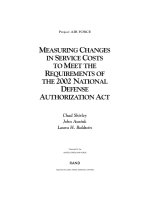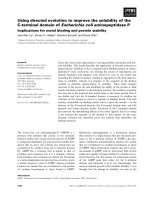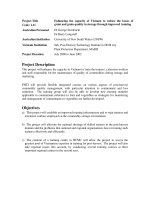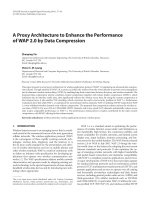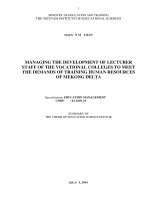IMPROVING VOCATIONAL TRAINING FOR VIETNAMESE RURAL LABORS TO MEET THE REQUIREMENTS OF AGRICULTURE 4.0.
Bạn đang xem bản rút gọn của tài liệu. Xem và tải ngay bản đầy đủ của tài liệu tại đây (600.78 KB, 109 trang )
MINISTRY OF EDUCATION AND TRAINING
FOREIGN TRADE UNIVERSITY
MASTER THESIS
IMPROVING VOCATIONAL TRAINING
FOR VIETNAMESE RURAL LABORS TO MEET
THE REQUIREMENTS OF AGRICULTURE 4.0
Major: International Economics
PHAM THI HONG LINH
Hanoi, 2020
MINISTRY OF EDUCATION AND TRAINING
FOREIGN TRADE UNIVERSITY
MASTER THESIS
IMPROVING VOCATIONAL TRAINING
FOR VIETNAMESE RURAL LABORS TO MEET
THE REQUIREMENTS OF AGRICULTURE 4.0
Major: International Economics
Full name : Pham Thi Hong Linh
Supervisor
: Assoc.Prof.Dr. Tu Thuy Anh
Hanoi, 2020
3
COMMITMENT
I hereby commit that the master thesis with the title “Improving vocational
training for Vietnamese rural labors to meet the requirements of Agriculture 4.0”
is my own scientific research. The data indicated in the thesis is clear, accurate
and collected from the confident sources of information.
Hanoi, 2020
The Author
Pham Thi Hong Linh
ACKNOWLEDGEMENTS
First of all, my warm gratitude is for the lecturers and staff of Faculty of
Graduate Studies, Foreign Trade University for their kindness and helpful support
during my coursework and development of this study, specially, Assoc.Prof.Dr . Tu
Thuy Anh, whose thoughtful orientation and guidance was invaluable.
Secondly, I would like to embrace my profound thankfulness to my
colleagues, friends, relevant organizations and individuals who supported me with a
lot of useful information and data.
Last but not least, I would like to take this opportunity to express the
appreciation for my beloved family who always motivate, encourage me and bring
the best conditions to me so that I could completely stay focused on the study.
In spite of the great efforts of the author, inevitable shortcomings and
limitation still exist in the thesis. Therefore, I am looking forward to receiving
precious sharings and comments for better improvement.
Sincerely,
The Author
Pham Thi Hong Linh
TABLE OF CONTENTS
COMMITMENT.......................................................................................................i
ACKNOWLEDGEMENTS.....................................................................................ii
LIST OF FIGURES...............................................................................................vii
LIST OF TABLES................................................................................................viii
ABSTRACT............................................................................................................. ix
INTRODUCTION....................................................................................................1
I. Research rationale.............................................................................................1
II. Literature review.............................................................................................3
III. Research objects, objectives and scopes.......................................................7
1. Objects...............................................................................................................7
2. Objectives..........................................................................................................8
3. Scopes................................................................................................................. 8
IV. Research methodology...................................................................................8
V. Research structure...........................................................................................8
CHAPTER I: THEORETICAL AND PRACTICAL FRAMEWORK OF
VOCATIONAL TRAINING FOR RURAL LABORS IN REQUIREMENTS
OF AGRICULTURE 4.0........................................................................................10
1.1. Definition of vocational training and vocational training for rural labors 10
1.1.1. Definition of vocational training.................................................................10
1.1.2. Definition of rural labors............................................................................13
1.1.3. Definition of vocational training for rural labors.......................................14
1.2. Roles and importance of vocational training for rural labors..................15
1.3. Components of vocational training for rural labors.................................17
1.3.1. Vocational trainees......................................................................................17
1.3.2. Vocational training infrastructure...............................................................19
1.3.3. Vocational training management officials and trainers..............................20
1.3.4. Vocational training programs and materials...............................................20
1.3.5. Training professions....................................................................................21
1.4. Factors influencing vocational training for rural labors..........................21
1.4.1. Guidelines and policies on vocational training for rural labors.................21
1.4.2. Information and communication on vocational training for rural labors . 23
1.4.3. Linkages of various partners in vocational training for rural labors..........24
1.4.4. Investment in vocational training for rural labors......................................25
1.5. Agriculture 4.0 and its requirements on vocational training for rural
labors...................................................................................................................26
1.5.1. Concepts of Agriculture 4.0........................................................................26
1.5.2. Characteristics and roles of Agriculture 4.0 in Vietnam.............................28
1.5.3. Requirements of Agriculture 4.0 on vocational training for rural labors....30
1.6. International and domestic experiences in the development of vocational
training for rural labors in Agriculture 4.0......................................................31
1.6.1. Experiences of Germany.............................................................................31
1.6.2. Experiences of China..................................................................................33
1.6.3. Experiences of Thailand..............................................................................34
1.6.4. Experiences of Bac Kan province...............................................................26
1.6.5. Experiences of Lam Dong province............................................................36
1.6.6. Lessons learned for Vietnam.......................................................................38
CHAPTER II: CURRENT SITUATION OF VOCATIONAL TRAINING FOR
VIETNAMESE RURAL LABORS IN REQUIREMENTS OF AGRICULTURE
4.0............................................................................................................................ 40
2.1. Vietnamese rural labors..............................................................................40
2.1.1. Vietnamese rural population and structure.................................................40
2.1.2. Quality of Vietnamese rural labors.............................................................43
2.1.3. Jobs of Vietnamese rural labors..................................................................44
2.1.4. Unemployment in the rural areas................................................................50
2.1.5. Underemployment of Vietnamese rural labors............................................52
2.1.6. Income of Vietnamese rural labors.............................................................53
2.2. Components of vocational training for Vietnamese rural labors.............55
2.2.1. Vocational trainees in Vietnam....................................................................55
2.2.2. Vocational training systems and infrastructure in Vietnam.........................58
2.2.3. Vocational training management officials and trainers in Vietnam.............60
2.2.4. Vocational training programs and materials for Vietnamese rural labors 60
2.2.5. Training professions for Vietnamese rural labors.......................................61
2.3. Analysis of factors influencing vocational training for Vietnamese rural
labors...................................................................................................................63
2.3.1. The implementation of guidelines and policy of the Vietnamese Party and
State on vocational training for rural labors
63
2.3.2. Information and communication on vocational training for Vietnamese
rural labors
67
2.3.3. Linkages of various partners in vocational training for Vietnamese rural
labors
68
2.3.4. Investment in vocational training for Vietnamese rural labors...................69
2.4. Assessment of vocational training for Vietnamese rural labors in
requirements of Agriculture 4.0.........................................................................71
2.4.1. Achievements..............................................................................................71
2.4.2. Effectiveness................................................................................................73
2.4.3. Shortcomings..............................................................................................74
2.4.4. Reasons for shortcomings...........................................................................76
CHAPTER
III:
SOLUTIONS
AND
RECOMMENDATIONS
ON
IMPROVING VOCATIONAL TRAINING FOR VIETNAMESE RURAL
LABORS TO MEET THE REQUIREMENTS OF AGRICULTURE 4.0
78
3.1. Bases for proposing solutions......................................................................78
3.1.2. Main viewpoint of vocational training for rural labors in Agriculture 4.0 78
3.1.3. Orientations on improving vocational training for rural labors to meet the
requirements of Agriculture 4.0
81
3.2. Solutions on improving vocational training for Vietnamese rural labors
to meet the requirements of Agriculture 4.0.....................................................82
3.2.1. Renewing policies and state management on the development of rural labor
forces
82
3.2.2. Innovating vocational training activities towards modernization associated
with the reality and needs of local, society and enterprises
84
3.2.3. Developing vocational training systems and diversifying vocational
training activities for rural labors
84
3.2.4. Capacity building for vocational training management officials and
trainers
85
3.2.5. Strengthening linkages between enterprises, school, rural youth and
supporting start-up for labors
86
3.2.6. Upgrading traditional and informal apprenticeship systems......................88
3.3. Recommendations........................................................................................88
3.3.1. For the government.....................................................................................88
3.3.2. For ministries and agencies........................................................................89
3.3.3. For training units and organizations..........................................................90
3.3.4. For enterprises............................................................................................90
3.3.5. For learners................................................................................................90
CONCLUSION.......................................................................................................91
REFERENCES.......................................................................................................93
LIST OF FIGURES
Figure 1.1: Types of VET benefits...........................................................................15
Figure 2.1: Population structure by rural - urban area and gender in 2010 – 2018
(%) ............................................................................................................................. 41
Figure 2.2: Population structure by age group in rural - urban area, 2010 - 2018. . .41
Figure 2.3: Rural - urban labor force in 2010 – 2018 (%)........................................42
Figure 2.4: Rural-urban employment restructuring, 2010-2018 (million people).....45
Figure 2.5: Jobs by rural - urban sector, 2010 - 2018 (million people).....................45
Figure 2.6: Rural - urban agricultural job structure in 2010 - 2018 (%)...................46
Figure 2.7: The total of labors working (million people).........................................49
Figure 2.8: Average monthly income of labors in the rural and urban area, 2010 –
2018 (thousand VND)..............................................................................................53
Figure 2.9: Average monthly income of labors by job types in 2010 – 2018
(thousand VND).......................................................................................................54
Figure 2.10: Average monthly income of labors by technical profession in the rural
– urban area, 2010 – 2018 (thousand VND).............................................................54
Figure 2.11: Number of rural labors receiving vocational training by types of jobs
(million people)........................................................................................................57
Figure 2.12: Number of rural labors receiving vocational training by types of rural
labors (thousand people)..........................................................................................57
Figure 2.13: Number of households receiving vocational training who escape from
poverty and got jobs with higher income.................................................................58
LIST OF TABLES
Table 2.1: Labor force participation rate in rural - urban areas................................43
in 2010 and 2018 (%)...............................................................................................43
Table 2.2: Employment structure by age group in the rural – urban area,
2010 –
2018 (%) .................................................................................................................... 47
Table 2.3: Labor structure by industry in the rural – urban area, 2010 - 2018..........48
Table 2.4: Amount and structure of unemployed rural labors in 2010 - 2018...........50
Table 2.5: Unemployment rate of rural - urban labors in 2010 - 2018......................52
Table 2.6: Average income difference between the rural and urban area in 2010 2018 (%)..................................................................................................................55
Table 2.7: The number of rural labors receiving vocational training by periods in
2010 – 2019 (million people)...................................................................................56
ABSTRACT
Vocational training for rural labors is one of the important tasks to create
human resources who are capable of adapting to the rapid changes of the labor
market, meeting the requirements of international integration, contributing to the
fast and sustainable development of the country. In Agriculture 4.0, the activity
needs to be strongly developed both in scale and quality for the growth and
sustainable development.
Actually, the quality of Vietnamese rural labors is not high and improved
slowly; the facilities and infrastructure, management staff, lecturers, programs, etc
are still limited. Besides, the mechanisms, policies, information
and
communication, cooperation of various partners, investment have been improved
recently but need upgrading to better meet the requirements of the new situation.
Therefore, proposed solutions from renovating the legal framework, supportive
policies on international integration in training, developing programs to meet the
needs of learners, enterprises and the labor market, improving high-quality
management team, trainers, strengthening linkages, cooperation, investment, etc are
of great importance, requiring the hands-on engagement of all sectors, enterprises
and the learners themselves.
13
INTRODUCTION
I. Research rationale
In the context of international integration nowadays, Vietnam agriculture,
farmers and rural areas have faced not only many new opportunities but also
challenges because of some objective factors, especially climate change, Industry
Revolution 4.0, competition in high quality human resources, agricultural trade, etc.
Agriculture has been playing an important role in Vietnam economy, however, in
the new situation, it is fundamental to develop a smart agriculture, knowledge-based
agriculture with high-tech application in order to effectively use resources, improve
productivity and quality with added value and sustainable development.
To develop Agriculture 4.0, it is necessary to have the convergence of many
factors, in which, developing high-quality human resources is a prerequisite
condition in all countries, including Vietnam. In fact, Vietnamese agricultural labor
force is at an advanced age and there is a shortage of skilled labors, skilled technical
workers. According to the World Bank, the quality of human resources in Vietnam
is currently only 3.79/10 points, ranking 11 th among 12 Asian
countries
participating in the ranking. Thus, developing human resources for Agriculture 4.0
is an urgent requirement for Vietnam. Success or failure, whether Vietnam makes
good use of opportunities or overcomes the risks and challenges from the present
Agriculture 4.0 depends much on the issue. Accordingly, rural human resources are
one of the most key parts of the rural labor force, which determines rural socioeconomic development processes in the general relationship of the country.
Vietnam has abundant human resources who are mainly in the rural area, therefore,
the development of rural human resources is vital in the overall development of the
country.
In the Socio-Economic Development Strategy of our country up to 2020
approved by the 11th National Party Congress, one of the breakthrough solutions to
achieve the goal of turning our country basically into an industrialized towards
modernity by 2020 is to develop and improve the quality of human resources,
including those receiving vocational training and job security policies for farmers.
Vocational training for rural labors is one of the core strategies, contributing to the
poverty reduction and social security in addition to improving the quality of rural
labors, meeting the requirements of industrialization and modernization, agricultural
and rural chemistry in the context of the Agricultural Revolution 4.0.
In the period from 2010 to present, the government has devoted numerous
resources to the implementation of the largest project ever in the field of vocational
training in terms of contents, scale and quality, which is Project 1956/QD-TTg dated
November 27, 2019 of the Prime Minister on “Vocational training for rural labors to
2020” with the goal "On average, vocational training for about 01 million rural
labors every year, of which 100,000 turns of commune cadres and civil servants are
trained and fostered. Improving the quality and effectiveness of vocational training,
aiming to create jobs, increase income for rural labors, contributing to restructuring
labor and economic structures, serving the cause of industrialization and
modernization of agriculture and rural areas, etc”. Some models have been initially
carried out effectively such as vocational training models for workers in specialized
areas and areas of industrial tree materials including tobacco, tea, coffee, short-term
vocational training model for farmers in the community (Long, 2018). Some results
that can be realized from the effectiveness of vocational training for rural labors, for
instance, vocational training have addressed the needs of learners associated with
the employment, raising the awareness of rural labors on training occupations,
applying scientific and technological advances into production, improving incomes
and creating jobs for a part of leisure workers, contributing to restructuring labor
structure in the rural areas, implementing into new rural models, etc.
However, the vocational training programs for rural labors also appear to
exist as the awareness of many people about vocational training policies is limited,
people tend to choose more hands-on jobs. It is the choice of a new career, even
though it has a higher income, the companionship of enterprises in vocational
training is still not high. Moreover, the Revolution of Agriculture 4.0 requires labors
in the rural areas to be highly skilled, quickly grasp the achievements of science,
technology and production, etc.
Therefore, the topic “Improving vocational training for Vietnamese rural
labors to meet the requirements of Agriculture 4.0” is chosen to exploit what are
the pros and cons of vocational training for rural labors in Vietnam, as a driving
force to find the solutions to improve it for the need of the Revolution of
Agriculture 4.0 in the country.
The master thesis is developed in order to find answers for the following
questions:
Firstly, what is the current situation of vocational training for Vietnamese
rural labors?
Secondly, what are the requirements of Agriculture 4.0 on Vietnamese rural
labors and if the vocational training for Vietnamese rural labors meet the
requirements?
Thirdly, what are the proposed solutions and recommendations to improve
the vocational training for rural labors at present?
II. Literature review
Revolution of Agriculture 4.0
Agriculture, in general, is perceived as the backbone of a country‟s economy
with the potential to create jobs and contribute to the social-economic development
(Baznet, 2015).
Klaus Schwab, Chairman of the World Economic Forum affirmed that
industrial revolution 4.0 based on the Internet connecting usage has a strong impact
on the world and economic sectors with the unprecedented breakthrough
technology, including breakthrough in the agriculture sector (Khanh, 2019). The
Agricultural Revolution 4.0 is included with the sustainability and security solutions
of the value chain of agricultural production, where digital information is available
to all relevant stakeholders inside and outside such as the activities of suppliers and
customers whose date are transmitted, processed, analyzed and conducted
automatically through the network. Agriculture 4.0 is also considered as a function
of smart agriculture, smart technology, smart design and smart business. Actually,
there is no complete model of Agriculture 4.0 in Vietnam (Kha, 2017).
Human resource development in the Revolution of Agriculture 4.0
Human resource development contributes to the success of the country's
industrialization and modernization, in which education and training play a decisive
role (Nguyen Thanh, 2001). Furthermore, human resources and human resource
development play an important role in the development of a person's qualification,
which is related to the salary that he or she can receive in the market (Mulligan &
Sala-i-Martin (1997). With the same opinion, Mankiw (2003) and Park (1977) also
stated that differences in the quality of human resources between developing
countries and developed countries lead to differences in labor productivity and
income. The higher the educational level is, the higher the level of the labor force
will be for the labors to earn a higher income. For traditional agricultural
production, there is no need to apply scientific and technological advances where
labors in agriculture, labor productivity and economic value of products are low,
leading to a low income of workers in the industry. Therefore, when agricultural
labors have professional qualifications, they can apply the studied techniques in
their production with high labor productivity, economic value products, which are
the conditions to increase the income.
Improving the quality of human resources in agriculture is a condition for
agricultural labors to have opportunities in improving their incomes and ensure the
basic needs of lives such as eating, dressing, staying and travelling; eliminating
poverty, temporary housing, lacking of clean water, improving the material and
spiritual lives of laborers. When basic needs are met, the motivation for labors to be
met is higher (Moorhead and Griffin, 1998).
Through increased labor productivity in the agricultural sector, comprehensive
growth of the economy is promoted that leads to a relative decline of the
agricultural sector in both GDP and the labor force (Timmer, 2009). According to
Timmer (2012), “the underlying cause and result of the structural transformation
process is the increase in agricultural labor productivity. There are three ways to
increase labor productivity in agriculture, of which, the first two are often linked
together: Applying technology and science to produce more agricultural goods on
the same scale; allowing labors in the agricultural sector to switch to other
occupations without dropping agricultural output. Lewis (1954) had the same
opinion that the process of surplus labor migration in the rural-agricultural areas
will accelerate the economic growth based on the development of industrial, service
and intensive agricultural growth, which means the growth on the basis of
increasing agricultural labor productivity.
In the Vietnam Human resource development plan for the 2011-2020 period
approved by the Prime Minister, the percentage of manpower trained in agriculture,
forestry and fishery sector will increase from 15.5% in 2010 to about 50% by 2020.
However, by the year, human resources in this sector will lack about 3.2 million
trained workers. According to the World Bank (WB), the quality of human
resources in Vietnam is currently only 3.79/10 points, ranking 11th among 12 Asian
countries participating in the ranking. The competitiveness index of Vietnamese
human resources reaches 3.39/10 points and the competitiveness of the economy
ranks 73/133 in the countries that were ranked (Lan, 2018).
It is necessary to be aware of the challenges of the quality of Vietnamese rural
human resources in the context of global competition. The World Bank has pointed
out that a country can only enter the Revolution 4.0 when it fully integrates 04
factors consisting of high quality human resources, information technology
infrastructure, creative enterprises and appropriate institutions. It shows that in both
the traditional and the digital economy, the quality of human resources remains the
decisive factor for the overall development (Tien, 2018).
International experiences show that the education and training in Agricultural
4.0 is a revolution to build ecosystems such as training research, businesses,
cooperation to create a research system in association with innovation and
continuous operation, changing fields and farmers into institutions and researchers
in order to provide data for research facilities and enterprises to create agricultural
products 4.0. In Vietnam, the construction of an agricultural education system 4.0
may not be immediately implemented, however, it is fundamental to raise the
awareness towards an innovative and continually innovative agricultural education
and training (Lan, 2018).
Particularly, training high-quality agricultural human resources must be linked
with renovating training programs towards social demand, renewing training
contents and methods, conducting training and increase linkages. The training
contents and programs must be connected with the process of agricultural and rural
industrialization and modernization, market mechanism, the rapid application of
advanced science and technology achievements in the world to develop a smart
agriculture for the sustainable development. Besides, government performs a
significant role in supporting new market access, product trading, finance,
flexibility in policies and infrastructures (Matthew, 2018).
Vocational training for rural labors in the international integration and
Agriculture 4.0
For many years, activities to ensure the quality of higher education, colleges
and vocational school system have been popularized and implemented continuously
in the world. However, the theoretical researches on vocational training quality still
exist many different points of view.
There is a fact that training in rural areas remains unequal in terms of quality,
accessibility and investment due to insufficient fund mobilization and equipment,
lacking of collaboration of relevant ministries, agencies and partners. Training
programs for rural areas are often supply driven with lacking of key topics such as
production planning and modern agricultural production, value addition, business
management and marketing, etc. As a result, the rural areas are losing their
attractiveness and young people see the rural life as hard labors on farms (OECD,
2017).
The vocational training for rural labors in our country has not been paid
adequate attention recently; many ministries and agencies, localities and society are
not fully aware of vocational training, including vocational training for rural labors,
considering it as a temporary task, not an ordinary and continuous work. The people
generally and farmers themselves particularly are not fully aware of the importance
of vocational training; surveys and forecasts of vocational training demands still
face many difficulties (Dai, 2012).
Therefore, the demand for vocational training needs coming from the reality of
the people, the socio-economic development situation of the country, each locality
and enterprises.
Furthermore, the system of vocational training in particular has not met the
requirements with some limitation on the quality of vocational trainers' training,
professional competence, weak practical teaching skills, limited pedagogical and
educational skills. In addition, the training program is backward (Thang, 2017).
In 2011, the Institute of Vocational Training and Science Research published a
model of "Vocational training and job creation for laborers in the land-use
conversion area". This is a book compiled based on research documents, practical
documents through topics, schemes of the institute and authors, domestic and
foreign agencies.
The contents of the work deal with the major issues of urbanization and its
implications for rural Vietnam; labors‟ vocational training needs and job creation
models for various rural labor groups. However, in the work of introducing a new
model at the general level, there have not been thorough reviews, so there have been
no assertions about the effectiveness and the level of application (Vuong, 2011).
From above papers, the research is needed to review the vocational training for
rural labors to meet the requirements of Agriculture 4.0 and propose some solutions,
especially roles of relevant stakeholders for the development of the issue as the
previous papers lack in-depth contents.
III. Research objects, objectives and scopes
1. Objects
The research aims to assess the current situation of vocational training for
rural labors in Vietnam, their achievements and limitations through providing an
overview of vocational training for rural labors and requirements of Agriculture 4.0
on the issue, how the requirements are met, then find comprehensive solutions and
recommendations for the improvement of vocational training for rural labors to
meet the requirements of Agriculture 4.0. Revolution, which contributes to raising
the quality of human resources in the context of international integration at present.
2. Objectives
The research is developed to get the following objectives:
Firstly, to provide an overview of vocational training for rural labors and
requirements of Agriculture 4.0 on the issue.
Secondly, to assess the situation of Vietnamese rural labors, the vocational
training for the subjects and how it meets the requirements of Agriculture 4.0.
Thirdly, to propose solutions to improve vocational training for Vietnamese
rural labors to meet the requirements of Agriculture 4.0 and produce
recommendations respect to relevant stakeholders.
3. Scopes
Most of the information and secondary data is available in the period of
2010-2018. Moreover, vocational training for Vietnamese rural labors are analysed
mainly through agricultural activities. Actually, there are two main types of
vocational training for rural labors in terms of occupations including agricultural
and non-agricultural training. However, due to the limitation framework of the
study, agriculture profession vocational training will get higher concentration.
IV. Research methodology
The research will be adopted with qualitative approach to achieve its
objectives. Methods of analysis, synthesis and comparison of the statistical data
collected from secondary data are made in order to learn better about the situation,
advantages, disadvantages and solution on vocational training for rural labors as well
as Agriculture 4.0. Some available sources will be used to get information such as
Ministry of Agriculture and Rural Development, Ministry of Labor, War Invalids
and Social Affairs, World Bank, General Statistics Office, VCCI, Vietnam
Partnership for the Development of Human Resources in Rural Area, etc. Promotion
and other related sources in the contents of the article to collect available data from
website, annual reports, newspapers, magazines and understand the results of
research topics, surveys of research institutions, agencies, governmental organization
or non- governmental organizations and social science, etc.
V. Research structure
In addition to the introduction, conclusion, references, the research includes
three chapters as follows:
Chapter I: Theoretical and practical framework of vocational training for
rural labors in requirements of Agriculture 4.0.
Chapter II: Current situation of vocational training for Vietnamese rural
labors in requirements of Agriculture 4.0.
Chapter III: Solutions and recommendations on improving vocational
training for Vietnamese rural labors to meet the requirements of Agriculture 4.0.
CHAPTER I: THEORETICAL AND PRACTICAL FRAMEWORK OF
VOCATIONAL TRAINING FOR RURAL LABORS IN REQUIREMENTS
OF AGRICULTURE 4.0
This chapter opens up some basic contents of vocational training for the rural
labors and Agriculture 4.0. Definition of vocational training, rural labors, its roles
and importance, 05 main components and 04 factors influencing vocational training
for rural labors are introduced. Moreover, the concepts, characteristics, roles,
requirements of Agriculture 4.0 on the activity are analyzed. The chapter will be a
basis for the study on the current situation of the issue in Vietnam.
1.1. Definition of vocational training and vocational training for rural labors
1.1.1. Definition of vocational training
International and domestic papers show that there are many different kinds of
interpretation in the definition of “vocational”. It can be understood through some
comprehension as follows:
According to Cambridge dictionary, “vocational” means providing skills and
education that prepare you for a job. “Vocational” is defined as a form of activity in
the social division of labor system, the whole knowledge and skills that an
employee needs to perform certain social activities in a certain field of labor”
(Chanh and Cau, 2008).
In other concept, it is defined that “vocational” is a form of labor division,
expressed by the combination of theoretical knowledge and practical basis to
complete certain tasks. The works arranged in a vocation are those that require the
same general theoretical knowledge, performed on the same machines, equipment,
and tools, creating products of the same type” (Uc, 2003).
Dai (2012) summarized the viewpoints of Russian scientists on describing the
concept of “vocational” as a labor‟s activity that requires certain training and often
being the source of survival while the French scientists considered “vocational” as
a kind of labor with habit of skills of a person to find the means of life. Therefore,
“vocational” is regarded as an activity, a specific form of human activities. It is
also a result of the division of social labor, there is social development, the vocation
will change accordingly.
The concept of “training” is often associated with education. They share the
same point that they focus on equipping knowledge and skills to develop the
capacity of workers. However, education is the activity and impact on capacity
practice and development (knowledge, skills, etc) and qualities (beliefs, characters,
morality, etc) of humans to be able to develop their fullest personality and become
positive to the society. In other words, education is a process of exploiting the
potentials of each person, contributing to improving the individual competencies
and qualities of both teachers and students towards a more complete approach that
meets the existing and development requirements of the human society. In other
aspect, “training” is aimed at specific competencies for workers to undertake
specific jobs. It is referred to the later stage when a person has reached a certain age
with a certain level of qualification. “Training” is a process of equipping workers
with certain knowledge and skills so that they can undertake a certain job” (Chanh
& Cau, 2008).
Moreover, training refers to the teaching of practical skills, career or
knowledge related to a specific field, therefore, trainees can acquire and master the
knowledge, skills and vocation in a systematic way in order to adapt to their lives
and take on a given job. There are many types of training consisting of basic and
intensive training, professional and vocational training, self-training, retraining,
distance training, etc.
Particularly, based on Karl Marx theory, “vocational training” includes the
following components: intellectual training, physical training such as some
activities in sport schools or military training schools and technical training in order
to help trainees to master the basic principles of all production processes and the
usage of the simplest production tools.
In the definition of International Labour Organization (ILO), it is stated that
vocational training is to provide learners with necessary skills to perform all the
tasks related to the assigned professional jobs. Activities are aimed at providing the
skills, knowledge and attitudes required for employment in a particular occupation,
or group of related occupations, in any field of economic activity.
Meanwhile, Workplace Testing explains that “vocational training” provides
individuals with targeted instruction intended to provide them with necessary
knowledge and skills to pursue a selected career. Individuals may receive vocational
training either as students seeking employment or employees on the job. A person
entering a vocational education program is seeking to learn about a specific trade or
craft. Vocational training is available for a various number of jobs including
welding, cooking, medical transcription and auto repairing. Some vocational
training programs provide students with certifications or licenses demonstrating
their competence following completion of the training program”.
In Vietnam, there are some kinds of definition on “vocational training”
mentioned below:
“Vocational training” is the process of
equipping employees with certain
professional knowledge so that they can undertake certain jobs” (Chanh & Cau, 2008).
The Law on Vocational Training issued on November 29, 2006 introduces the
following concept: “Vocational training is a teaching and learning activity aimed at
equipping necessary vocational knowledge, skills and attitudes for trainees to find a
job by themselves or create a job after completing the training course”. In other
words, vocational training is a structured, purposeful process for trainees to
formulate and develop systematical knowledge, skills and professional attitudes to
meet the demand of society, including nation‟s demands, enterproses‟ demands and
learners‟ demands.
The Law on Vocational Education and Training passed by the National
Assembly Term XIII on November 27, 2014 stipulates that there are three levels of
training including elementary level, intermediate level and diploma.
According, the objective of vocational training is to train direct technical
labors in production and services with professional practice that are competent with
the level of training, having ethics, professional conscience, sense of discipline and
behavior, good health to create conditions for vocational trainees after graduation to
be able to find jobs, create jobs for themselves or study at a higher level, meeting
the requirements of the country in the new context of international integration.
1.1.2. Definition of rural labors
Based on the concept of the United Nations (UN), "labor force” is the total
potentials and forces that show the strengths and impacts of human on natural and
social improvement".
Another way of definition by ILO is that "the labor force” is a part of the
population of prescribed age, actually, they engage in working and the people who
are not employed are actively seeking jobs".
UNESCO – UNEVOC (International Centre for Technical and Vocational
Education and Training) defines that labor force includes all persons of working age
who furnish the supply of labor force for the production of goods and services as
identified by the United Nations System of National Accounts (SNA) production
boundary during a specified time reference period. It refers to the sum of all persons
in the working age who are employed and those who are unemployed.
In fact, the specific provisions on the working age are different among
countries, over periods in the same country, depending on the level of its economy
development. The majority of countries stipulating the lower bound (minimum age)
of the working age is 15 years old while the upper bound (maximum age) varies
from 60 years to 65 years.
In Vietnam, the labor force is determined as a part of the population aged from
15 who has a job and they are unemployed people. The labor force in the concept is
synonymous with the economically active population and reflects the practical
capacity of labor supply of society. According to the Labor Law, the working age is
15 to 60 for men and 15 to 55 for women. If the employee works as a manager and
in some other special cases, this person may retire at a higher age but must not
exceed 05 years.
In addition to the prescribed age, the rural labor force also includes people
who are out of the working age, which means those who are over or beyond the
working age as prescribed by the state, but actually participate in the labor force.
According to current regulation, people out of the working age include those who
are aged at least 61 (for males), 56 (for females) and males and females aged 13 to
14. Workers beyond the prescribed age participate in voluntary labor, not included
